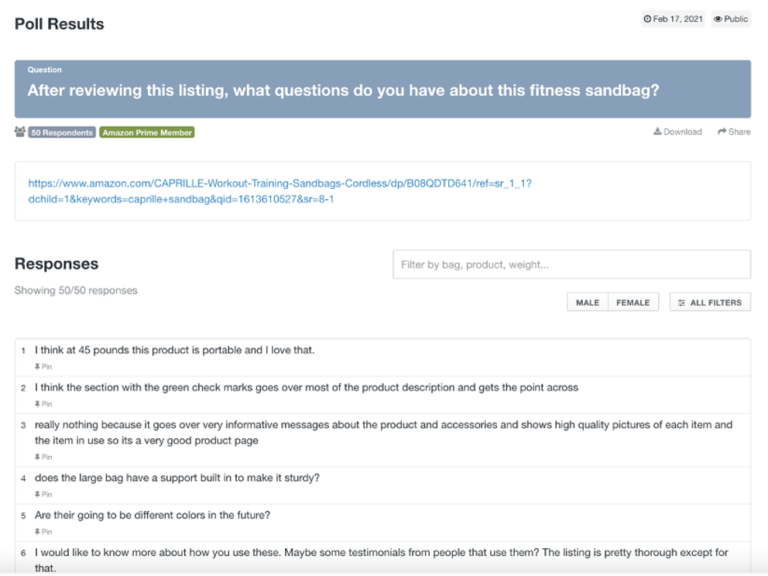Optimize Your Amazon Listings by Split Testing on PickFu
Here is a statistic that every Amazon seller should know…
about 70% of Amazon shoppers don’t scroll past the first page of search results.
If your product listing doesn’t make it onto that first page, most people will never see it. To stand a chance with Amazon’s A10 algorithm and get the attention of your customers, you must optimize your listings.

Let’s discuss how split testing can help you improve your Amazon listings so they get seen and you get sales.
The key to Amazon listing optimization
Listing optimization is not a one-and-done step. It’s an ongoing process of making sure each element of your product listing, from the main image to the description, is the best it can be.
The A10 algorithm considers several factors when deciding which listings get top billing.
Among the factors:
- Seller authority. Your sales history, seller reputation, and customer ratings all matter to Amazon’s search engine.
- Impressions. The more impressions, or views, your product gets, the higher you rank. On the flip side, the higher you rank, the more views your listing gets.
- Click-through rate (CTR). Amazon looks closely at how many times people click on your product from the search results page.
- Conversions. A key metric, conversions counts the number of views that convert to a sale.
- Outside sales. The more traffic and sales you draw from outside of Amazon, the better.

The key to listing optimization is not only to understand how the A10 algorithm works but also what makes your customers tick.
That’s where split testing and PickFu come in.
What is split testing?
Split testing, also known as A/B testing, is a method to test variations of your product listing to see which does better with your target audience.
Split testing on Amazon happens live. You direct traffic to one version of your listing for a certain amount of time, then switch to the second version and run that for the same period. (Amazon offers a split testing feature, Manage Your Experiments, for testing A+ Content, but it’s only available for select sellers who qualify.)
Split testing tools like Splitly and Listing Dojo will manage the process for you on Amazon. The data reveals how customers behave and engage with your product page.
Did they linger longer on one listing?…
Which version had a higher CTR?…
But there are limitations to split testing on Amazon. You need to have a certain amount of traffic and sales to begin with, otherwise you won’t get enough data to make a difference. And even with enough data, live split tests usually take weeks to get results.

Because you’re testing with actual customers on Amazon, you also risk losing sales if your listing variation doesn’t perform well.
The algorithm will take note and your search ranking could suffer as a result.
Split testing outside of Amazon
Remember that you’re not just optimizing your listing for the A10 algorithm.
You’re also optimizing for people…
PickFu is a polling tool that enables you to run private split tests outside of Amazon with a respondent pool that matches the target market for your product.
For example, you can specify only Amazon Prime members, or tailor the audience by age, income, education level, specific interests
— whatever makes sense for your product and the customers you want to reach.

Use PickFu to split test your entire listing or each element independently: product description, main image, bullet points, and more. Respondents give you detailed written feedback quickly, at a fraction of the cost of a traditional split test.
Since you’re not testing live within the Amazon marketplace, you’ll get a firm grasp on what customers want before you commit to inventory or start production.
How does PickFu work?
When you’ve decided what to test, create a poll on PickFu, input a question, and upload your options
— up to eight in one poll. You can upload product images, links to your listings, even videos.
You can also gather open-ended feedback on your listing, such as in this PickFu poll:
The poll below was a product image split test with 50 Amazon Prime members.
Their votes and responses came back in 20 minutes.
What can you split test on PickFu?
Using PickFu, you can test every element of your product listing.
As mentioned above, you can also ask respondents for their opinions, which is especially helpful if you’re unsure about pricing or you want to know how your product compares to others.
Consider these four key areas to split test on PickFu:




Amazon listing optimization is a continual process. Keep in mind that there’s more to it than making the search engine happy. After all, real people, not algorithms, buy your products.
With the audience feedback you receive on PickFu, you’ll understand the why behind the data.
Use PickFu as a complement to live split testing on Amazon and you’ll be on your way to optimizing your listings and ultimately growing your sales.
With us, you will get 50% Off Your First Poll.




